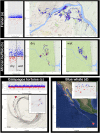Classification of Animal Movement Behavior through Residence in Space and Time
- PMID: 28045906
- PMCID: PMC5207689
- DOI: 10.1371/journal.pone.0168513
Classification of Animal Movement Behavior through Residence in Space and Time
Abstract
Identification and classification of behavior states in animal movement data can be complex, temporally biased, time-intensive, scale-dependent, and unstandardized across studies and taxa. Large movement datasets are increasingly common and there is a need for efficient methods of data exploration that adjust to the individual variability of each track. We present the Residence in Space and Time (RST) method to classify behavior patterns in movement data based on the concept that behavior states can be partitioned by the amount of space and time occupied in an area of constant scale. Using normalized values of Residence Time and Residence Distance within a constant search radius, RST is able to differentiate behavior patterns that are time-intensive (e.g., rest), time & distance-intensive (e.g., area restricted search), and transit (short time and distance). We use grey-headed albatross (Thalassarche chrysostoma) GPS tracks to demonstrate RST's ability to classify behavior patterns and adjust to the inherent scale and individuality of each track. Next, we evaluate RST's ability to discriminate between behavior states relative to other classical movement metrics. We then temporally sub-sample albatross track data to illustrate RST's response to less resolved data. Finally, we evaluate RST's performance using datasets from four taxa with diverse ecology, functional scales, ecosystems, and data-types. We conclude that RST is a robust, rapid, and flexible method for detailed exploratory analysis and meta-analyses of behavioral states in animal movement data based on its ability to integrate distance and time measurements into one descriptive metric of behavior groupings. Given the increasing amount of animal movement data collected, it is timely and useful to implement a consistent metric of behavior classification to enable efficient and comparative analyses. Overall, the application of RST to objectively explore and compare behavior patterns in movement data can enhance our fine- and broad- scale understanding of animal movement ecology.
Conflict of interest statement
The National Institute of Water and Atmospheric Research, Ltd. (NIWA) provided support in the form of salaries for authors LGT and DRT, and the collection of the Galapagos tortoise track was supported by e-obs GmbH, but these commercial affiliations do not alter our adherence to PLOS ONE policies on sharing data and materials.
Figures







Similar articles
-
Using dynamic Brownian bridge movement modelling to measure temporal patterns of habitat selection.J Anim Ecol. 2014 Sep;83(5):1234-43. doi: 10.1111/1365-2656.12205. Epub 2014 Mar 6. J Anim Ecol. 2014. PMID: 24460723
-
3D tracking of animals in the field using rotational stereo videography.J Exp Biol. 2015 Aug;218(Pt 16):2496-504. doi: 10.1242/jeb.118422. Epub 2015 Jun 8. J Exp Biol. 2015. PMID: 26056245
-
Assessment and statistical modeling of the relationship between remotely sensed aerosol optical depth and PM2.5 in the eastern United States.Res Rep Health Eff Inst. 2012 May;(167):5-83; discussion 85-91. Res Rep Health Eff Inst. 2012. PMID: 22838153
-
State-space models of individual animal movement.Trends Ecol Evol. 2008 Feb;23(2):87-94. doi: 10.1016/j.tree.2007.10.009. Epub 2008 Jan 11. Trends Ecol Evol. 2008. PMID: 18191283 Review.
-
ECOLOGY. Terrestrial animal tracking as an eye on life and planet.Science. 2015 Jun 12;348(6240):aaa2478. doi: 10.1126/science.aaa2478. Science. 2015. PMID: 26068858 Review.
Cited by
-
Behavioural movement strategies in cyclic models.Sci Rep. 2021 Mar 19;11(1):6413. doi: 10.1038/s41598-021-85590-y. Sci Rep. 2021. PMID: 33742025 Free PMC article.
-
Resting costs too: the relative importance of active and resting energy expenditure in a sub-arctic seabird.J Exp Biol. 2022 Feb 15;225(4):jeb243548. doi: 10.1242/jeb.243548. Epub 2022 Feb 16. J Exp Biol. 2022. PMID: 35019973 Free PMC article.
-
Jaguar movement behavior: using trajectories and association rule mining algorithms to unveil behavioral states and social interactions.PLoS One. 2021 Feb 4;16(2):e0246233. doi: 10.1371/journal.pone.0246233. eCollection 2021. PLoS One. 2021. PMID: 33539384 Free PMC article.
-
Quantifying individual specialization using tracking data: a case study on two species of albatrosses.Mar Biol. 2018;165(10):152. doi: 10.1007/s00227-018-3408-x. Epub 2018 Sep 8. Mar Biol. 2018. PMID: 30220735 Free PMC article.
-
Exploring indirect effects of a classic trophic cascade between urchins and kelp on zooplankton and whales.Sci Rep. 2024 Apr 29;14(1):9815. doi: 10.1038/s41598-024-59964-x. Sci Rep. 2024. PMID: 38684814 Free PMC article.
References
-
- Fauchald P, Tveraa T. Using first-passage time in the analysis of area-restricted search and habitat selection. Ecology. 2003; 84: 282–8.
-
- Barraquand F, Benhamou S. Animal movements in heterogeneous landscapes: Identifying profitable places and homogeneous movement bouts. Ecology. 2008; 89: 3336–48. - PubMed
-
- Pedersen MW, Patterson TA, Thygesen UH, Madsen H. Estimating animal behavior and residency from movement data. Oikos. 2011; 120: 1281–90.
-
- Kareiva P, Odell G. Swarms of Predators Exhibit "Preytaxis" if Individual Predators Use Area-Restricted Search. Am Nat. 1987; 130: 233–70.
MeSH terms
LinkOut - more resources
Full Text Sources
Other Literature Sources

